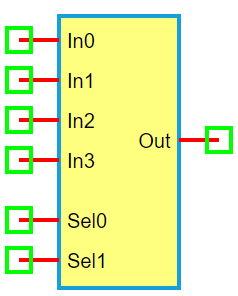4-to-1 Multiplexer
Information

A 4-to-1 multiplexer (MUX) is a digital circuit that selects one of four input signals and forwards it to the output based on the value of two select lines (Sel0 and Sel1).
Selection logic:
Sel1 Sel0 = 00 → Out = In0
Sel1 Sel0 = 01 → Out = In1
Sel1 Sel0 = 10 → Out = In2
Sel1 Sel0 = 11 → Out = In3
Truth Table
Sel1 |
Sel0 |
In0 |
In1 |
In2 |
In3 |
Out |
|---|---|---|---|---|---|---|
0 |
0 |
X |
X |
X |
X |
In0 |
0 |
1 |
X |
X |
X |
X |
In1 |
1 |
0 |
X |
X |
X |
X |
In2 |
1 |
1 |
X |
X |
X |
X |
In3 |
Ports
In0: Input 0
In1: Input 1
In2: Input 2
In3: Input 3
Sel0: Least significant select bit
Sel1: Most significant select bit
Out: Output signal
Model
The MUX4to1 model implements a 4-input, 2-select digital multiplexer.
Attributes:
In0–In3 (dsignal): Four digital input lines
Sel0, Sel1 (dsignal): Select lines
Out (dsignal): Output line
Methods:
digital(): Determines output based on the binary value of (Sel1, Sel0)
from pyams.lib import dsignal, model
class MUX4to1(model):
""" 4-to-1 Multiplexer """
def __init__(self, In0, In1, In2, In3, Sel0, Sel1, Out):
self.In0 = dsignal(direction='in', port=In0)
self.In1 = dsignal(direction='in', port=In1)
self.In2 = dsignal(direction='in', port=In2)
self.In3 = dsignal(direction='in', port=In3)
self.Sel0 = dsignal(direction='in', port=Sel0)
self.Sel1 = dsignal(direction='in', port=Sel1)
self.Out = dsignal(direction='out', port=Out)
def digital(self):
""" Perform 4-to-1 MUX logic """
s0 = self.Sel0
s1 = self.Sel1
self.Out += (~s1 & ~s0 & self.In0) | \
(~s1 & s0 & self.In1) | \
(s1 & ~s0 & self.In2) | \
(s1 & s0 & self.In3)
Command syntax
The syntax for defining a 4-to-1 multiplexer in a PyAMS simulation:
# Import the model
from pyams.models import MUX4to1
# MUX4: instance name
# In0–In3: data inputs; Sel0, Sel1: select lines; Out: output
MUX4 = MUX4to1(In0, In1, In2, In3, Sel0, Sel1, Out)